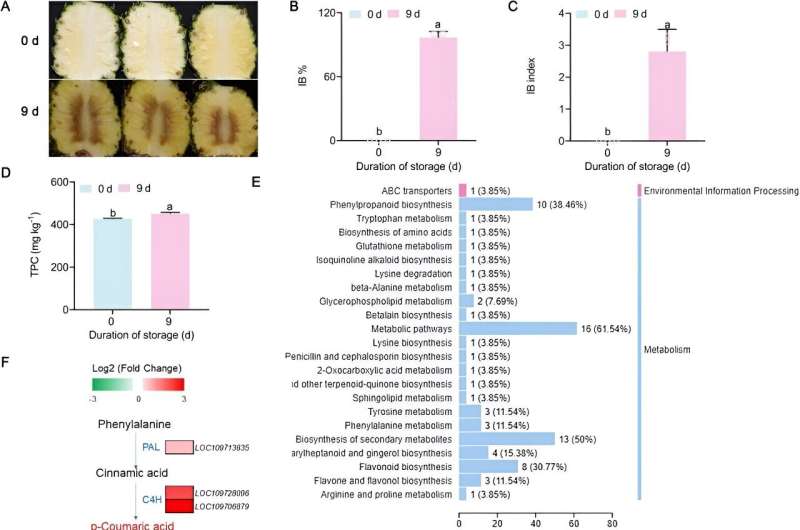This article has been reviewed according to Science X's editorial process and policies. Editors have highlighted the following attributes while ensuring the content's credibility:
fact-checked
trusted source
proofread
Unlocking the mechanism of pineapple internal browning

Internal browning (IB) is a significant post-harvest issue in pineapples, impacting fruit quality and leading to substantial losses, yet its mechanism remains poorly understood. Studies have shown that the accumulation of phenolic compounds plays a key role in tissue browning development.
While the role of basic helix-loop-helix (bHLH) transcription factors (TFs) in regulating secondary metabolites like phenolic compounds is well-documented, their specific involvement in IB, particularly through phenolic biosynthesis in senescing harvested fruit, is unclear. Additionally, abscisic acid (ABA) suppressed IB of harvested pineapples, but whether that process involves the regulation of a bHLH TF remains unknown.
In September 2023, Horticulture Research published research titled "AcbHLH144 transcription factor negatively regulates phenolic biosynthesis to modulate pineapple internal browning."
Initially, by examining pineapples stored for nine days, researchers identified a correlation between severe symptoms of IB and increased total phenolic compounds (TPC), supported by metabolomics and transcriptomics analyses which highlighted the phenylpropanoid biosynthesis pathway's activation.
Eleven differentially expressed genes (DEGs) for all six phenolic biosynthetic enzymes were significantly upregulated in IB-affected fruit, indicating enhanced phenolic biosynthesis linked to IB development. The study further investigated the transcription regulation of phenolic biosynthesis, identifying AcbHLH144 among several transcription factors with altered expression in stored pineapples.
Interestingly, AcbHLH144 expression negatively correlated with key phenolic biosynthetic genes, suggesting that AcbHLH144 may negatively regulate the biosynthesis of phenolic compounds in pineapple fruit during storage.
To validate AcbHLH144's regulatory function, the researchers conducted transient overexpression in pineapples and overexpression Arabidopsis, demonstrating that AcbHLH144 overexpression led to decreased phenolic accumulation, supporting its role as a negative regulator of phenolic biosynthesis.
Furthermore, the Y1H and EMSA showed that AcbHLH144 directly bound to the Ac4CL5 promoter and the dual-luciferase reporter assay showed that it inactivated Ac4CL5 transcription. This regulatory mechanism was further implicated in the context of ABA treatment, which reduced IB severity and phenolic compound accumulation, with ABA treatment significantly upregulating AcbHLH144 transcription.
This upregulation was linked to ABA-responsive elements in the AcbHLH144 promoter, suggesting ABA's role in activating AcbHLH144 transcription, thereby inhibiting phenolic biosynthesis and mitigating IB. Collectively, these results showed that AcbHLH144 as a repressor for phenolic biosynthesis could be activated by ABA.
Overall, the study presents a detailed investigation into the mechanisms underlying pineapple IB, highlighting the crucial role of AcbHLH144 in regulating phenolic compound biosynthesis and the potential of ABA in controlling IB through the activation of AcbHLH144.
These findings contribute significantly to our understanding of fruit browning physiology and suggest novel approaches for managing post-harvest IB in pineapples.
More information: Qian Li et al, AcbHLH144 transcription factor negatively regulates phenolic biosynthesis to modulate pineapple internal browning, Horticulture Research (2023). DOI: 10.1093/hr/uhad185
Provided by NanJing Agricultural University





















